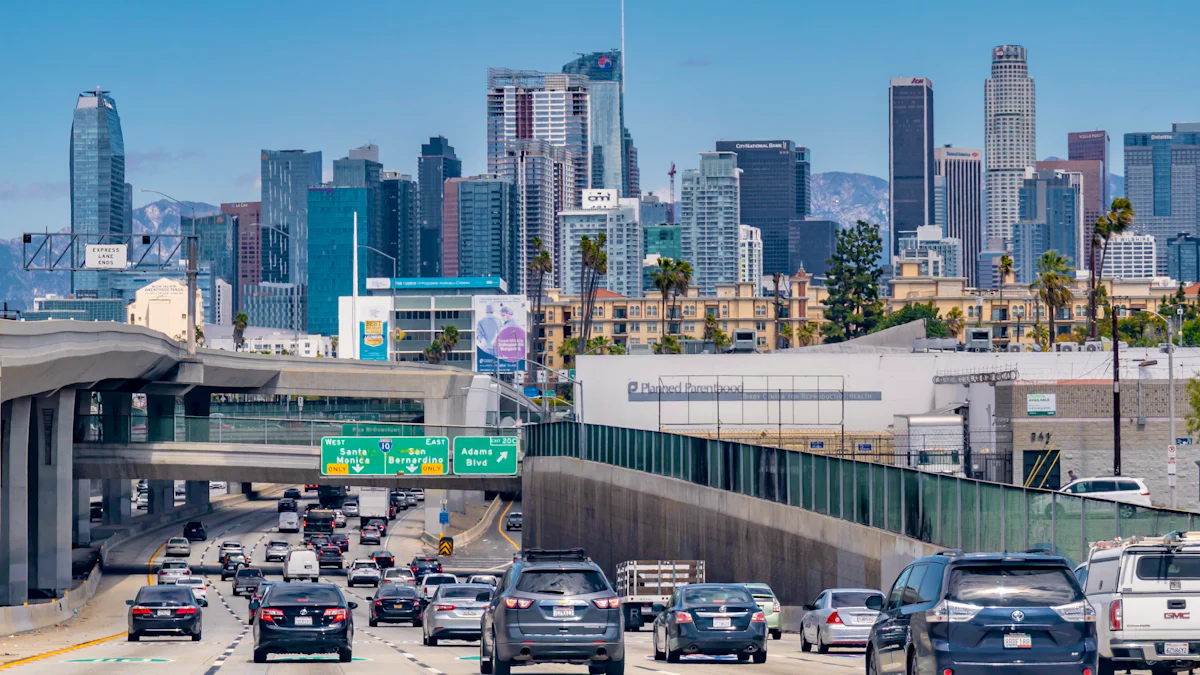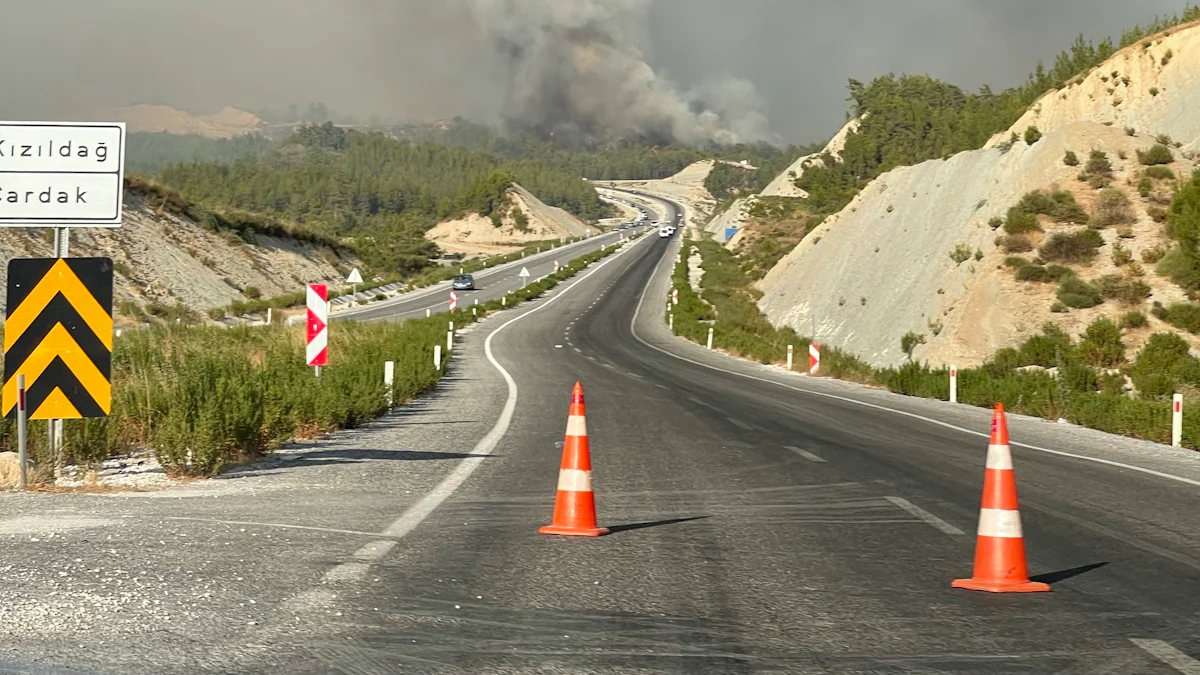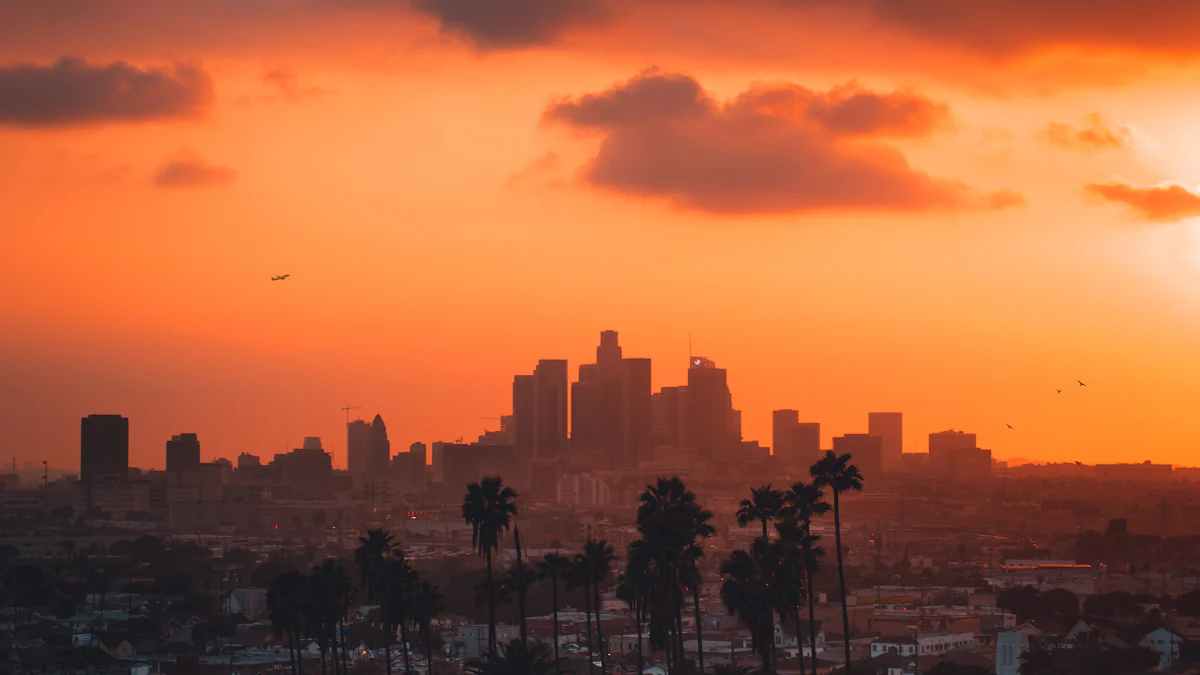Airlines and Highways Affected by Los Angeles Wildfires in 2025

Wildfires in Los Angeles have caused significant travel disruption, creating immediate challenges for residents and visitors. Public transit operations face interruptions, with LA Metro suspending fare collection to assist evacuees. Road closures, including major highways like I-210 and I-5, have led to severe transit delays and congestion. Smoke from the fires has further reduced visibility, complicating transportation logistics. Freight carriers and other transportation services are closely monitoring the situation, as the risk of broader disruptions remains high. Adapting quickly to these conditions is essential for ensuring safety and mobility during this crisis.
Overview of Wildfires in Los Angeles
Locations and Severity of Wildfires
The wildfires in Los Angeles during 2025 have been among the most destructive in recent history. Several major fires have ravaged the region, including:
Palisades Fire: Over 17,234 acres burned, making it the most destructive wildfire in Los Angeles County history.
Eaton Fire: Spanning 10,600 acres, this fire has caused significant damage.
Lidia Fire: Although smaller at 348 acres, it remains only 60% contained.
Hurst Fire and Sunset Fire: Locations unspecified, but both have contributed to the widespread devastation.
These wildfires have displaced over 175,000 people and claimed at least five lives. The total acreage burned exceeds 26,978 acres, with over 1,000 structures destroyed. The estimated damage runs into tens of billions of dollars, highlighting the severity of the crisis.
Containment Efforts and Challenges
Efforts to contain the wildfires involve a massive deployment of resources. Approximately 2,300 firefighters are actively battling the Palisades Fire alone. Agencies such as CAL FIRE, LA County Fire, LA City Fire, and LAPD are collaborating to enhance coordination. Advanced technologies, including predictive modeling and fire spread tracking, are being utilized to improve response strategies.
However, firefighters face significant challenges. Complex terrain with steep slopes and dense vegetation hampers containment efforts. Extreme weather conditions, including strong winds, exacerbate the situation by spreading embers rapidly. Health risks from smoke exposure and toxic substances further complicate operations. Additionally, the expanding Wildland Urban Interface disrupts evacuations and critical infrastructure, making containment even more difficult.
Broader Impacts of California Wildfires
The 2025 wildfires have far-reaching environmental and economic consequences. Air quality has deteriorated significantly, affecting public health and local ecosystems. Over 420,000 residents have experienced power outages, further straining community resources. Economically, the wildfires have caused an estimated $52 to $57 billion in damages, making them one of the costliest natural disasters in U.S. history. Insured losses alone are projected at $20 billion, with over 9,000 structures destroyed. These impacts underscore the devastating toll of wildfires on California's communities and infrastructure.
Air Travel Disruptions Due to Wildfires

Flight Cancellations and Delays
The wildfires near Los Angeles have significantly disrupted air travel, leading to widespread flight cancellations and delays. At Los Angeles International Airport (LAX), 27 departing flights were canceled, representing 3% of its daily capacity, while 26 arrivals were also canceled. Additionally, 140 departures and 109 arrivals faced delays, accounting for 15% and 12% of daily operations, respectively. Since the fires began, LAX has recorded 126 total flight cancellations, with one in five departures delayed on the worst day. Hollywood Burbank Airport (BUR) also experienced severe disruptions, with 41 cancellations and 98 delays. These issues stem from reduced visibility caused by wildfire smoke and the Federal Aviation Administration's (FAA) need to manage air traffic flow under such conditions.
Airline Policies and Responses
Fee Waivers and Rebooking Options
Airlines have implemented flexible policies to assist passengers affected by the flight disruption. United Airlines allows passengers to rebook flights between January 7 and January 17, 2025, without fare differences if the origin and destination remain unchanged. American Airlines offers waivers for tickets booked by January 7 for travel between January 8 and January 15, 2025, provided the travel cities remain the same. Southwest Airlines provides a 14-day rebooking window with no additional charges, even for non-refundable tickets. These policies aim to minimize inconvenience for travelers during this challenging period.
Communication Channels for Travelers
Airlines are actively communicating with passengers to ensure they stay informed about disruptions. They encourage travelers to check flight statuses regularly and contact customer service early for assistance. Many airlines have also emphasized the importance of staying updated on local conditions. Flight waivers and rescheduling options are prominently displayed on airline websites, making it easier for passengers to access critical information.
Airports Affected by Wildfires Near Los Angeles
The wildfires have disrupted operations at multiple airports in the region. LAX has faced significant delays and cancellations due to increased air traffic from firefighting aircraft and visibility issues caused by smoke. Hollywood Burbank Airport (BUR) canceled 41 out of 70 scheduled departures on one day due to high winds and smoke. Ontario International Airport and John Wayne Airport have also reported disruptions, though to a lesser extent. These challenges highlight the widespread impact of wildfires on transportation and the need for temporary flight restrictions to ensure safety.
Highway Closures and Traffic Impacts

Major Highways Affected
Pacific Coast Highway and Interstate 405
The wildfires in Los Angeles have caused significant highway closures, severely impacting transportation. The Pacific Coast Highway (CA-1) remains fully closed between Malibu and Santa Monica due to heavy smoke and fire damage. Interstate 405, a critical artery for commuters, has experienced partial closures, leading to increased traffic congestion in surrounding areas. These closures have disrupted daily commutes and emergency response efforts, highlighting the widespread impact of the wildfires on regional mobility.
Alternate Routes and Detours
Drivers are encouraged to use alternate routes to navigate around the affected areas. For those traveling near the Pacific Coast Highway, detours through inland routes such as US-101 provide a viable alternative. Similarly, commuters impacted by closures on Interstate 405 can consider using Sepulveda Boulevard or other parallel streets. Navigation apps with real-time updates are essential for identifying the best available routes and avoiding delays caused by ongoing highway closures.
Traffic Conditions and Delays
The wildfires have created severe delays across Los Angeles. Road closures on major highways, including I-210 near Roxford Street and I-5 connectors to I-210, have compounded traffic congestion. Additionally, malfunctioning traffic lights caused by power outages have worsened conditions, requiring drivers to treat dark signals as stop signs. Smoke from the fires has further reduced visibility, making travel hazardous and increasing the likelihood of accidents. These challenges emphasize the need for drivers to remain vigilant and plan for extended travel times.
Safety Advisories for Drivers
Authorities have issued several safety advisories for those traveling near wildfire-affected areas. Drivers should check wildfire conditions before departing and avoid active fire zones. Keeping windows closed and using the vehicle's recirculate mode can limit smoke exposure. Maintaining clean windows, mirrors, and headlights ensures better visibility in smoky conditions. Emergency kits with essentials like food, water, and first aid supplies are highly recommended. Drivers should also stay alert, reduce speed, and maintain a safe distance from other vehicles to prevent accidents. Following these precautions can help ensure safety during this challenging time.
Practical Advice for Travelers
Air Travel Tips
Monitoring Flight Statuses
Travelers should adopt proactive measures to stay informed about flight disruptions caused by wildfires in Los Angeles.
Check flight statuses regularly through airline websites or mobile apps to track delays and cancellations.
Contact airlines early to explore rescheduling options or request waivers.
Pack essentials like chargers, snacks, and travel documents in carry-on luggage to prepare for extended wait times.
Stay informed about local wildfire developments through updates from authorities and fire departments.
Consider alternative routes, such as nearby airports or other modes of transportation, if flights face significant disruptions.
Flexible Travel Planning
Flexibility in travel plans can mitigate the impact of wildfire-related disruptions. Travelers should monitor flight statuses frequently and remain prepared to adjust itineraries. Booking refundable tickets or purchasing travel insurance can provide additional security. Historical events, such as the Eyjafjallajökull volcanic eruption in 2010, demonstrate how adaptable travelers faced fewer delays and costs compared to those with rigid plans.
Road Travel Tips
Using Navigation Apps for Real-Time Updates
Drivers navigating wildfire-affected areas should rely on advanced navigation tools for real-time updates. Apps like HERE Real-Time Traffic and Sygic GPS Navigation provide accurate traffic conditions and optimal routing. Glob offers additional features, including alerts for road hazards and accidents. These tools help drivers avoid road closures and estimate travel times effectively.
Emergency Preparedness for Drivers
Travelers driving near wildfire zones must prioritize safety.
Slow down and maintain a safe distance from other vehicles.
Use headlights and hazard lights to improve visibility.
Keep windows closed to limit smoke exposure.
Carry an emergency kit with essentials such as water, non-perishable food, a first aid kit, and a flashlight.
Plan alternate routes in advance and stay alert for traffic control personnel.
General Safety Recommendations for All Travelers
All travelers should remain vigilant during wildfire emergencies. Checking wildfire conditions before departure is crucial. Avoid active fire zones and monitor air quality reports to minimize smoke exposure. Allow extra time for travel due to potential delays and road closures. Keeping windows, mirrors, and headlights clean ensures better visibility. Staying informed through local government communications and social media updates can enhance safety and preparedness.
The 2025 Los Angeles wildfires have severely disrupted transportation systems, highlighting the vulnerability of critical infrastructure during natural disasters. Key impacts include:
Smoke reducing visibility and air quality, causing accidents and delays on major routes like Interstate 5.
Highway closures and mass evacuations halting trucking operations and non-emergency activities.
Interruptions in delivery services within affected zones due to roadblocks and safety concerns.
Staying informed and prepared is essential for minimizing risks during such crises. Travelers and residents should monitor official updates, use navigation tools for real-time traffic conditions, and follow safety advisories.
Lessons from these wildfires underscore the need for improved transportation resilience:
Strategy | Importance |
|---|---|
Enhances resource mobilization and logistical support during emergencies. | |
Technology integration | Facilitates real-time tracking and coordinated responses. |
Continuous innovation | Adapts to evolving challenges with climate-resilient strategies. |
By adopting these measures, communities can better withstand future disruptions and ensure safer travel during emergencies.
See Also
Exploring Tomorrow's LTL Freight Landscape: An In-Depth Review
Enhancing Supply Chain Performance: Five Key Trends Ahead
Sustainable Logistics Success: Insights Into JUSDA's Expansion
